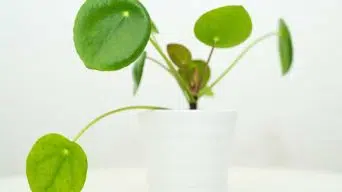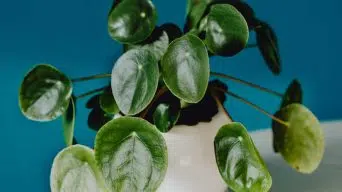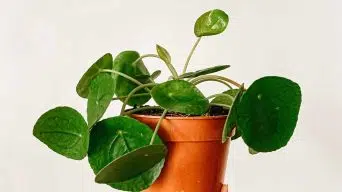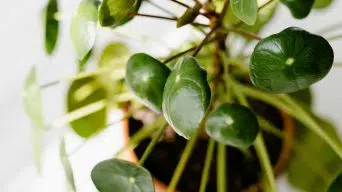The Pilea plant, also known as the Chinese Money Plant, is a popular houseplant because it is relatively easy to care for.
Pileas are tolerant of a wide range of growing conditions and can even survive periods of neglect.
However, one of the most common problems people have with their pilea plants is overwatering.
If you think that your pilea plant may be overwatered, here’s what you need to know about the signs, causes, and treatment of this problem.
What Are the Risks of Overwatering a Pilea Plant
Pilea plants are native to tropical and subtropical regions of the world.
They grow in humid conditions with plenty of rainfall in their natural habitat.
As houseplants, they are used to growing in potting mix that is well-draining and does not stay wet for long periods.
When pilea plants are overwatered, the potting mix stays wet for too long and can start to break down.
This can lead to several problems, including:
Root Rot
This is one of the most common problems associated with overwatering.
Pilea root rot is caused by a build-up of water in the potting mix, which leads to the roots being submerged in water for long periods.
This can cause the roots to start to decompose and rot away.
When this happens, the plant will not be able to uptake water or nutrients from the potting mix, and it will start to wilt.
Eventually, the plant will die if the problem is not treated.
Fungal Growth
Overwatering can also lead to fungal growth on the plant or in the potting mix.
Fungi thrive in wet conditions, so if the potting mix is constantly wet, it can start to support the growth of fungi.
This can harm the plant, as some fungi can cause root rot.
Powdery mildew, a fungal disease, is common in overwatered plants.
It appears as a white or grey powdery substance on the leaves and stems of indoor plants.
Powdery mildew can cause the Pilea leaves to turn yellow and drop off, eventually killing the plant if it is not treated.
Bacterial Growth
Like fungi, bacteria thrive in wet conditions.
If the potting mix is constantly wet, it can start to support the growth of bacteria.
Bacteria can cause several plant problems, including root rot and leaf spot diseases.
Leaf spot diseases appear as small brown or black spots on the plant’s leaves.
They can eventually kill the Pilea leaves if they are not treated.
Pest Infestation
Overwatered plants are also more susceptible to pest infestations.
Pests such as aphids, mealybugs, and spider mites love to feed on stressed plants or have weak defenses.
If your plant is overwatered, it will be more vulnerable to an infestation.
Pest infestations can cause several problems, including leaf loss, stunted growth, and eventually death.
How Does Overwatering a Pilea Occur?
Overwatering is the most common problem people have with their pilea plants.
There are several reasons why this can happen:
Incorrect Potting Mix
One of the most common causes of overwatering is using the wrong potting mix.
Pilea plants need a well-draining potting mix that does not stay wet for long periods.
If you use a potting mix that is too dense or does not drain well, it will hold onto water for too long, and your plant will start to suffer.
Poor Drainage
Another common cause of overwatering is poor drainage.
If your pot does not have drainage holes, the water will not be able to drain out of the pot, and your plant will start to sit in water.
This can lead to some problems, including root rot and fungal growth.
Watering Too Often
Another common mistake people make is watering their plants too often.
Pilea plants need to be watered when the potting mix is dry.
In general, this means watering once a week.
If you water your Pilea more often than this, the potting mix will not have a chance to dry out, and your plant will start to suffer.
Weather Conditions
Weather conditions can also play a role in overwatering.
If it is raining a lot or there is high humidity, your plant will not need to be watered as often.
On the other hand, if it is very hot and dry, your plant will need to be watered more often.
Paying attention to the weather conditions will help you avoid overwatering your plant.
Using the Wrong Water
Using the wrong water can also lead to overwatering.
Pilea plants prefer filtered or distilled water.
If you use tap water, it can contain chemicals that can build up in the potting mix, making it difficult for the plant to absorb moisture.
This can stress the plant and eventually lead to overwatering.
Not Checking the Soil
Another mistake people make is not checking the soil before watering their plants.
You should always check the potting mix before watering your plant.
If the potting mix is already wet, there is no need to water the plant.
Watering a plant that doesn’t need it can lead to overwatering and all of the problems that come with it.
Using too Much Fertilizer
Using too much fertilizer can also lead to overwatering.
Fertilizers can contain salts that can build up in the potting mix and make it difficult for the plant to absorb moisture.
If you use too much fertilizer, it can stress the plant and eventually lead to overwatering.
If you think you might have used too much fertilizer, flush the potting mix with water to remove the excess salt.
How To Identify If Your Pilea Is Overwatered
Pilea plants are susceptible to overwatering, and it can cause several problems.
It’s essential to catch the problem early so that you can take steps to treat it.
That’s why it’s essential to know the signs of overwatering.
Signs of an Overwatered Pilea Plant
There are some signs that you can look for to determine if your plant is overwatered:
1. Drooping Leaves
One of the first signs of overwatering is drooping leaves.
This is because the plant is not getting enough oxygen, and the leaves are essentially suffocating.
If you see your Pilea leaves drooping, it’s a good indication that you’re overwatering it.
2. Yellow Leaves
Yellow leaves are another common sign of overwatering.
This is because when the roots of a plant are soggy, they can’t get the oxygen they need to function correctly.
As a result, the Pilea leaves may turn yellow and drop off.
Although yellow leaves can indicate other problems, such as nutrient deficiencies or pests, overwatering is the most common cause.
3. Brown Leaves
Brown leaves are another sign that your plant is overwatered.
If the leaves on your plant are brown and mushy, it is a sign that they are not getting enough oxygen.
Brown leaves can also be a sign of root rot caused by too much water.
If you see brown leaves on your plant, it is vital to take action immediately.
4. Soft Stems
Soft stems are another sign of overwatering.
The stems of your plant will feel mushy and weak and may even bend or break easily.
This is because the waterlogged roots cannot effectively transport nutrients and moisture to the rest of the plant.
This cause the stems to become weak and unable to support the weight of the leaves.
5. Soggy and Smelly Soil
If you notice that the soil in your pot is soggy or smells bad, it is a sign of overwatering.
When the roots of a plant are waterlogged, they start to rot.
This can cause the soil to become soggy and may even give off a foul odor.
If you notice either of these signs, it is vital to take action immediately.
6. Slow Growth
If your plant is not growing as quickly as it should be, it could be a sign of overwatering.
When the roots are soggy, they cannot absorb the nutrients they need for growth.
As a result, your plant may start to grow slowly or even stop growing altogether.
7. Fungus or Mold
If you notice fungus or mold growing on the soil, it is a sign of overwatering.
Fungus and mold thrive in wet and humid conditions, so they are often the first to appear when a plant is overwatered.
You may also notice white, fuzzy growth on your plant’s leaves.
This is a type of mold called powdery mildew, and it can be a sign of overwatering.
How To Save an Overwatered Pilea Plant
If you think your plant is overwatered, it’s essential to take action immediately.
The sooner you catch the problem, the easier it will be to save your plant.
Here are some tips for saving an overwatered Pilea plant:
1. Stop Watering
The first step is to stop watering your plant.
Let the soil dry out completely before you water it again.
If the plant is in a pot, you may need to empty the water that has accumulated in the bottom.
This will give the plant time to dry out and the roots to recover.
2. Repot the Plant
If you think the plant is waterlogged, you may need to repot it.
Carefully remove the plant from its pot and inspect the roots.
If they are mushy or have started to rot, you will need to cut them off.
Once you have trimmed the damaged roots, you can repot the plant in fresh soil.
3. Provide Good Drainage
If you think your plant is overwatered, it’s crucial to provide good drainage.
This will help to prevent the roots from becoming waterlogged.
You can improve drainage by adding sand or gravel to the potting mix.
You can also make sure the pot has drainage holes in the bottom.
4. Give the Plant More Light
Giving your plant more light will also help to prevent overwatering.
Pilea plants need bright indirect light to thrive.
If you think your plant is getting too much water, move it to a brighter location.
However, avoid placing it in direct sunlight, as this can scorch the plant leaves.
5. Improve Air Circulation
Improving air circulation will also help to prevent overwatering.
Pilea plants need good airflow to stay healthy.
You can improve air circulation by moving the plant to a different location or opening a window.
You can also try using a fan to create a gentle breeze.
6. Remove Dead Leaves
If your plant is overwatered, the leaves may start to turn brown and die.
It’s essential to remove these dead leaves so that the plant can focus its energy on new growth.
To remove dead leaves, snip them off with a pair of scissors.
Be sure to dispose of them in the trash so that they don’t spread any diseases to other plants.
7. Don’t Fertilize
If you think your plant is overwatered, it’s best to wait before fertilizing.
Applying fertilizer to an overwatered plant can burn the roots and further damage the plant.
Wait until the plant has recovered from overwatering before fertilizing it.
How To Prevent Overwatering a Pilea Plant
The best way to prevent overwatering is to be proactive.
Here are some tips for preventing overwatering a Pilea plant:
1. Check the Soil Before Watering
Before you water your plant, it’s essential to check the soil.
Stick your finger into the soil and see how moist it is.
If the soil is dry, it’s time to water the plant.
If the soil is wet, wait a few days before watering again.
2. Use the Right Potting Mix
When you repot your plant, use a well-draining potting mix.
A good potting mix will help to prevent the roots from becoming waterlogged.
Add sand or gravel to regular potting soil to make your own well-draining potting mix.
3. Water Deeply but Infrequently
When you water your plant, it’s essential to water it deeply but infrequently.
This means watering the plant until the soil is saturated and then allowing the soil to dry out completely before watering again.
4. Don’t Let the Plant Sit in Water
After you water your plant, it’s essential to empty any water collected in the bottom of the pot.
If the plant sits in water for too long, the roots will start to rot.
5. Don’t Mist the Leaves
Misting the leaves of your plant can do more harm than good.
Constantly wet leaves are more susceptible to diseases.
It’s better to water the plant at the base and allow the water to soak up through the roots.
6. Use a Pot with Drainage Holes
When potting your plant, be sure to use a pot with drainage holes in the bottom.
This will help to prevent the roots from becoming waterlogged.
7. Avoid Fertilizing Too Often
Fertilizing your plant can make the problem of overwatering worse.
Overfertilizing can burn the roots and damage the plant, so it’s best to fertilize sparingly.
Only fertilize your plant when it’s actively growing, and don’t apply fertilizer more than once a month.
8. Water in the Morning
Watering your plant in the morning will give it the entire day to dry out.
If you water your plant in the evening, the leaves will stay wet overnight and be more susceptible to diseases.
Final Thoughts
Overwatering is a common problem for Pilea plants.
If you think your Money plant is overwatered, it’s important to take action immediately.
This article’s tips will help you identify, treat, and prevent overwatering.
With a little bit of care, you can keep your Pilea plant healthy and happy for many years to come.







